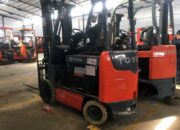How to clean and maintain electric forklifts
During long-term use, electric forklifts will accumulate a lot of dirt, which will affect the vehicle’s ability to operate, not meeting the factory’s 5S regulations, so cleaning becomes even more important. Forklifts are frequently overlooked.
Each enterprise will add related regulations and requirements on cleaning and maintaining forklifts to the forklift operating rules and regulations, but the specific operating methods are not clear. There are often some misunderstandings in daily cleaning such as washing directly with water, cleaning the electric forklift in this way will damage the forklift.
To save labor and time, forklift drivers wash their forklifts with bottled water or water pipes, or even rinse them directly with a high-pressure water gun. The sealing effect of electric forklifts is not better than that of cars, the design of electric forklifts is to operate indoors, without rain cover or waterproof function.
Everyone knows electrical circuit components are very sensitive to water, after washing the electric forklift body with water, water will flow down the base according to the gap between the body and the gap between the pedals, causing damage to the electrical circuit components.
First, there will be some “soft faults”, that is, a bad forklift that has been damaged for a while and cannot be repaired. Then there is damage to electrical circuit components, need to replace electrical switches, cooling fans, cruise switches, … and even overhaul the engine. Serious is the battery or other circuit short circuit, smoke and fire during operation, forklift burned.
Notes when cleaning forklifts
Power must be turned off while the forklift is being cleaned. After parking, the battery must be changed and cleaned, and at the same time turned off the power when not operating the electric forklift, otherwise it may accidentally touch the forklift control switch and cause an accident. It is also possible to short circuit the negative and positive terminals of batteries or other electronic components when using damp cloths or other metal tools. The forklift battery voltage itself exceeds the human body load, there is a risk of electric shock.
The first is to clean the outside of the electric forklift. Before cleaning, it is necessary to turn off the different power sources of the vehicle to avoid electrical damage due to shorting the vehicle during the cleaning process. The outside of the forklift can be cleaned with a damp cloth. When cleaning the different voltage components of the electric forklift, you can use compressed air to blow away the dust above the voltage, it should be noted that the voltage components cannot be washed with a high pressure water gun.
After cleaning the electric forklift, please check the details or parts that need to be lubricated, and add lubricating oil in a timely manner. The battery of the electric stacker can be washed with water, but the water cannot get inside the battery cell. Raise it to wash to prevent water from entering some components of the forklift.
In order to maintain the flexible operation of electric forklift tires, the wheel attachments and other parts must be removed in time after each transport is completed to avoid affecting the operation of the vehicle.
What should be paid attention to when maintaining electric forklifts?
In order for forklifts to operate reliably and to maximize their full potential, regular maintenance measures must be taken. General technical maintenance measures are as follows:
– Periodic maintenance, after each shift.
– First-level technical maintenance, after 100 hours of cumulative work, a single-shift system is necessary for the forklift to operate normally and reliably, bringing out the full potential of the forklift. , and regular maintenance measures
General technical maintenance measures are as follows:
– Periodic maintenance, after each shift.
– Technical maintenance level one, after working for 100 hours cumulatively, the technical maintenance measures of a single-shift system are generally as follows:
– Periodic maintenance, after each shift.
– Technical maintenance level 1, after 100 working hours, one shift is equivalent to 2 weeks.
– Secondary technical maintenance, after 500 cumulative working hours, the system phase works one shift 1 periodical maintenance







